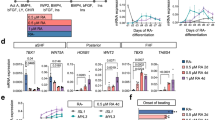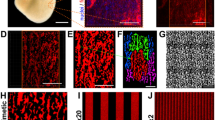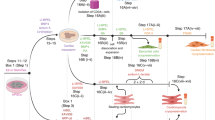Abstract
Primate nonhuman and human embryonic stem (ES) cells provide a powerful model of early cardiogenesis. Furthermore, engineering of cardiac progenitors or cardiomyocytes from ES cells offers a tool for drug screening in toxicology or to search for molecules to improve and scale up the process of cardiac differentiation using high-throughput screening technology, as well as a source of cell therapy of heart failure. Spontaneous differentiation of ES cells into cardiomyocytes is, however, limited. Herein, we describe a simple protocol to commit both rhesus and human ES cells toward a cardiac lineage and to sort out early cardiac progenitors. Primate ES cells are challenged for 4 d with the cardiogenic morphogen bone morphogenetic protein 2 (BMP2) and sorted out using anti-SSEA-1 antibody-conjugated magnetic beads. Cardiac progenitor cells can be generated and isolated in 4 d using this protocol.
This is a preview of subscription content, access via your institution
Access options
Subscribe to this journal
Receive 12 print issues and online access
$259.00 per year
only $21.58 per issue
Buy this article
- Purchase on SpringerLink
- Instant access to full article PDF
Prices may be subject to local taxes which are calculated during checkout




Similar content being viewed by others
References
Smith, A.G. Culture and differentiation of embryonic stem cells. J. Tissue Cult. Methods 13, 89–94 (1991).
Cezar, G.G. Can human embryonic stem cells contribute to the discovery of safer and more effective drugs? Curr. Opin. Chem. Biol. 11, 405–409 (2007).
Bushway, P.J. & Mercola, M. High-throughput screening for modulators of stem cell differentiation. Methods Enzymol. 414, 300–316 (2006).
Pucéat, M. & Ballis, A. Embryonic stem cells: from bench to bedside. Clin. Pharmacol. Ther. 82, 337–339 (2007).
Kattman, S.J., Adler, E.D. & Keller, G.M. Specification of multipotential cardiovascular progenitor cells during embryonic stem cell differentiation and embryonic development. Trends Cardiovasc. Med. 17, 240–246 (2007).
Yang, L. et al. Human cardiovascular progenitor cells develop from a KDR(+) embryonic-stem-cell-derived population. Nature 453, 524–528 (2008).
Laflamme, M.A. et al. Cardiomyocytes derived from human embryonic stem cells in pro-survival factors enhance function of infarcted rat hearts. Nat. Biotechnol. 25, 1015–1024 (2007).
Pucéat, M. TGFbeta in the differentiation of embryonic stem cells. Cardiovasc. Res. 74, 256–271 (2006).
Ménard, C. et al. Cardiac specification of embryonic stem cells. J. Cell. Biochem. 93, 681–687 (2004).
Tomescot, A. et al. Differentiation in vivo of cardiac committed human embryonic stem cells in post-myocardial infarcted rats. Stem Cells 25, 2200–2205 (2007).
Hoffman, L.M. & Carpenter, M.K. Characterization and culture of human embryonic stem cells. Nat. Biotechnol. 23, 699–708 (2005).
Yao, S. et al. Long-term self-renewal and directed differentiation of human embryonic stem cells in chemically defined conditions. Proc. Natl. Acad. Sci. USA 103, 6907–6912 (2006).
Dunwoodie, S.L. Combinatorial signaling in the heart orchestrates cardiac induction, lineage specification and chamber formation. Semin. Cell Dev. Biol. 18, 54–66 (2007).
Nolan, T., Hands, R.E. & Bustin, S.A. Quantification of mRNA using real-time RT-PCR. Nat. Protoc. 1, 1559–1582 (2006).
Mitalipov, S. et al. Isolation and characterization of novel rhesus monkey embryonic stem cell lines. Stem Cells 24, 2177–2186 (2006).
Cowan, C.A. et al. Derivation of embryonic stem-cell lines from human blastocysts. N. Engl. J. Med. 350, 1353–1356 (2004).
Amit, M. & Itskovitz-Eldor, J. Derivation and maintenance of human embryonic stem cells. Methods Mol. Biol. 331, 43–53 (2006).
Zeineddine, D. et al. Oct-3/4 dose dependently regulates specification of embryonic stem cells toward a cardiac lineage and early heart development. Dev. Cell 11, 535–546 (2006).
Stefanovic, S. & Pucéat, M. Oct-3/4: not just a gatekeeper of pluripotency for embryonic stem cell, a cell fate instructor through a gene dosage effect. Cell Cycle 6, 8–10 (2007).
Acknowledgements
The authors acknowledge the National Agency of Research (ANR) for supporting their research as well as providing salaries for J.L. and S.S. The Evry Genopole is also acknowledged for its financial support to the team. The authors thank Drs Cowan, Itskovitz and Amit, Hovatta and Mitalipov for generously providing the cell lines and for their continuous scientific support.
Author information
Authors and Affiliations
Corresponding author
Rights and permissions
About this article
Cite this article
Leschik, J., Stefanovic, S., Brinon, B. et al. Cardiac commitment of primate embryonic stem cells. Nat Protoc 3, 1381–1387 (2008). https://doi.org/10.1038/nprot.2008.116
Published:
Issue date:
DOI: https://doi.org/10.1038/nprot.2008.116
This article is cited by
-
Extracellular vesicles from human embryonic stem cell-derived cardiovascular progenitor cells promote cardiac infarct healing through reducing cardiomyocyte death and promoting angiogenesis
Cell Death & Disease (2020)
-
Mitral valve disease—morphology and mechanisms
Nature Reviews Cardiology (2015)
-
Highly efficient induction and long-term maintenance of multipotent cardiovascular progenitors from human pluripotent stem cells under defined conditions
Cell Research (2013)
-
Lentiviral vectors and cardiovascular diseases: a genetic tool for manipulating cardiomyocyte differentiation and function
Gene Therapy (2012)
-
Cell-based Therapy for Heart Disease: A Clinically Oriented Perspective
Molecular Therapy (2009)




PUCEAT michel
In this paper we report a cell sorting protocol using an anti-CD15 antibody conjugated to magnetic beads (CD15 microbeads Miltenyi Biotec, cat. no. 130-046-601). We recently encountered problems with this antibody which lost the recognition of the BMP2-induced CD15 in human ES cells derived mesodermal cells, likely due to a derivation of the hybridoma used by Miltenyi to produce this monoclonal antibody. CD15 (or Lewis Antigen) is a complex carbohydrate antigen found on glycolipids, and in oligosaccharides of glycoproteins. It is close but not identical to SSEA-1 which contains the Lewis antigen (or CD15). CD15 can be found in cells modified by a syalyl or a sulphate group, a modification which will change the recognition of the Antigen by monoclonal antibodies. Thus, several anti-CD15 commercially available antibodies recognize not only the carbohydrate of interest but also some surrounding carbohydrate groups and possibly even amino acid of the carrier glycoprotein at the membrane of the cell. The clonal purity of the antibody used in our protocol to specifically sort out BMP2-induced mesodermal MesP1+cells is thus critical to get the right cell phenotype. We have solved the problem by screening many antibodies and in turn using another clone from another company (i.e. Exbio). We would like to alert the readers of our paper about this antibody concern to make sure that our protocol is successful in their laboratories. we apologize to some researchers who might have encountered problems in reproducing our data . Please make sure that sorted cells feature the right gene expression profile as reported in this paper or our J Clin Invest paper in 2010 Blin et al) . Please do not hesitate to contact us if you have any question. (michel.puceat@inserm.fr)